
The bark mantises and ground mantises are praying mantids now placed in the family Eremiaphilidae that are native to the Afrotropics. They are generally light brown but more silvery on the wings. The wings are attractively reticulated, and the veins may be mottled dark and pale. The head is wider than the pronotum, which is rounded anteriorly, and doesn't overlap with the rear of the head. The pronotum is depressed, with its sides more or less parallel, and only a weak supra-coxal bulge is present. The anterior tibia are flattened and greatly expanded longitudinally, and the tibial claw does not fit into a pit between the 1st and 2nd external spines of the anterior femora, as in a few mantis groups.

Nezara viridula, commonly known as the southern green stink bug (USA), southern green shield bug (UK) or green vegetable bug, is a plant-feeding stink bug. Believed to have originated in Ethiopia, it can now be found across the world. Because of its preference for certain species of legumes, such as beans and soybeans, it is an economically important pest on such crops.
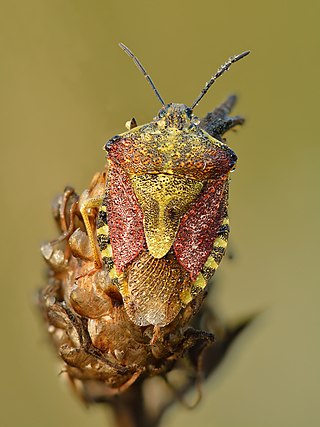
Carpocoris purpureipennis is a species of shield bug of the family Pentatomidae, subfamily Pentatominae.
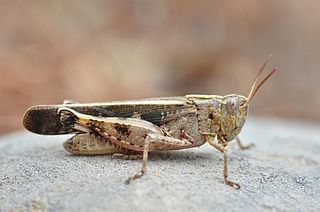
Aiolopus strepens is a species of grasshopper belonging to the family Acrididae, subfamily Oedipodinae.
Adelphocoris rapidus, common names for which are rapid plant bug or superb plant bug, is a species of Hemiptera in the family Miridae, that can be found everywhere in the United States, and in the Peace–Athabasca Delta, Canada. The species are larger than other members of the family, and are either yellowish-black or orange-black coloured.

Gonocerus acuteangulatus is a herbivorous species of true bug in the family Coreidae. It is commonly known as the box bug in the UK as it once only occurred in Box Hill in Surrey where it fed on box trees.
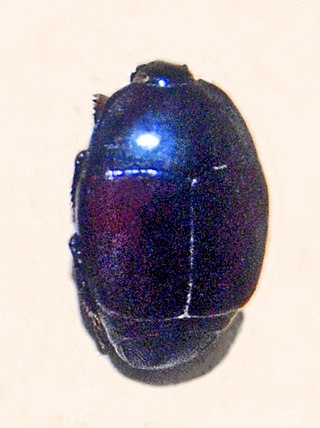
Saprinus splendens is a species of clown beetles belonging to the family Histeridae.
Paraulax ronquisti is a species of gall wasp. Biology of the Paraulax species is unknown but given they are associated with Nothofagus forests their biology is probably associated with the pteromalid gall community. It is named in honour of Fredrik Ronquist. This species differs from P. perplexa and P. queulensis by its body's red-brown color, the shape of the antennal flagellomeres F3 and F4, the faint notauli and its smooth and shiny mesopleuron. It has an elongated body like P. queulensis.
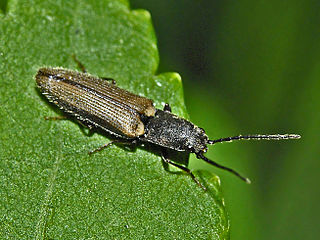
Athous bicolor is a species of click beetles.
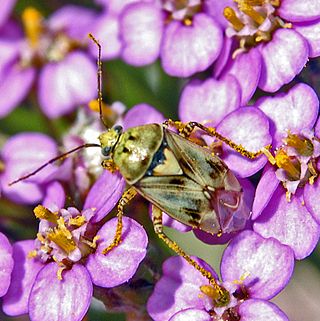
Lygus gemellatus is a species of plant-feeding insects in the family Miridae.
Eustra shanghaiensis, is a species of flanged bombardier beetle belonging to the family Carabidae. It is endemic to China.
Melasis fermini is a rare species of soldier beetles native to a small area of Spain. It has only been found in three locations in Guadalajara, Caceres, and Ciudad Real, and its estimated range is less than twelve square kilometers. The species was named in honor of the late Fermín Martín Piera, a Spanish biologist and taxonomist who specialized in the study of dung beetles.
Platynaspis flavoguttata is a species of lady beetle native to India, Sri Lanka and Myanmar.
Holotrichia danielssoni is a species of dung beetle found in Sri Lanka.

Liatongus rhadamistus, or Scaptodera rhadamistus, is a species of dung beetle found in India, Sri Lanka, Laos and Thailand.
Harmatelia bilinea, is a species of firefly beetle endemic to Sri Lanka.

Hydaticus pacificus, is a species of predaceous diving beetle found in South and South East Asia.
Alcidodes virgatus, is a species of weevil found in Sri Lanka.

Euobrimus cavernosus is a representative of the stick insects native to the Philippines. It is considered one of the largest species in the subfamily Obriminae.
Holostrophus toyoshimai is a species of polypore fungus beetle in the family Tetratomidae. Being identified in 2017 by Masahiro Saitȏ and Ondřej Konvička, Holostrophus toyoshimai was identified upon the discovery of five specimens located within central Honshu to which they were identified as a new species.













